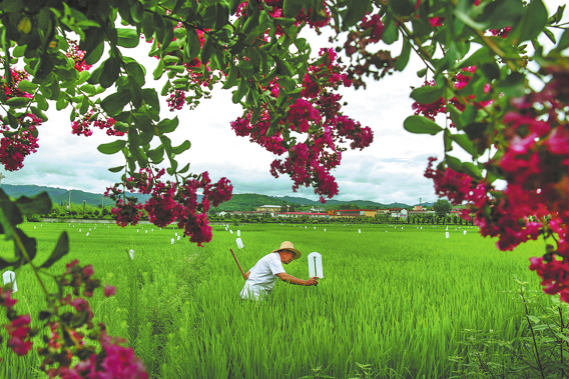Vibrant dragon patterns offer glimpse into Tibetan traditional culture
Xinhua | Updated: 2024-03-26 11:44
On Monday morning in Lhasa, capital of Southwest China's Xizang autonomous region, a group of local primary school students were skillfully crafting vivid dragon-shaped paper cuttings with their quick hands in Xizang's first multi-ethnic themed exhibition hall for teenagers.
Docents of the exhibition hall, hailing from different ethnic groups, guided the children in the delicate paper-cutting. "This year is the Year of the Dragon, so we chose dragon-shaped patterns for the activity. In Chinese culture, the dragon represents positive images such as strength, dignity, auspiciousness, and prosperity. Its image is also commonly seen in Xizang's traditions," said Dorje Tsering, a 21-year-old docent.
Likewise, during this Tibetan New Year holiday, dozens of Tibetan children, dressed in traditional attire, were sitting beneath a big screen with colorful cartoon depictions of the Chinese dragon, or Loong, at a festive event in Lhasa. This year, the Tibetan New Year coincided with the Spring Festival, or the Lunar New Year, with both occurring on Feb 10.
The event in Lhasa centered around Tibetan costumes for children. According to the organizer, Konchog Drolma, she wanted to explain the origin of the Year of the Dragon to children through picture books.
"The year 2024 is the Year of the Dragon, and it's a great opportunity for my child to gain a deeper understanding of the traditional Tibetan New Year and local traditional culture," said Tenzin Wangmo, a parent of one of the participating children.
The culture associated with the Dragon has a long history in the region. In the ethnic traditional culture, "Lu" (the "Dragon" in Tibetan language) refers to various Dragon-like deities and spirits differing in forms, nature and functions but all possessing tremendous power.
Many places in the region are named after "Lu," such as Dzongyab Lukhang Park and Lugu community in Lhasa, and Lunang Township in the city of Nyingchi.
Today, these places have become popular destinations for entertainment and leisure among people of all ethnic groups in Xizang.
In an ancient courtyard of Lhasa, a bustling cultural market was held during the Tibetan New Year holiday. Deyang runs a stall offering distinctive handicrafts featuring the Dragon adorned in vibrant Tibetan attire. "They are fairly popular among the locals," she said.
Nearby at the Barkhor shopping center, the atmosphere buzzed with energy. Lozang, hailing from the city of Xigaze, showcased neatly stacked stalls featuring Dragon-patterned couplets, fruit platters and ceramic bowls in his shopping stall.
Even the handles of the "Chema," wooden boxes filled with colorful grains and barley flour, symbolizing good fortune and prosperity for the Tibetan New Year, were adorned with Dragon figurines.
He said that a sizable mural depicting the Dragon, measuring 2 meters in height and 2.4 meters in width, can be found at Shalu Monastery in his hometown.
Established in 1087, the monastery features a Dragon image on its north mural, symbolizing the history of cultural exchanges and integration between Han and Tibetan cultures.
"Even after thousands of years, the vibrant patterns of the Dragon endure across the region," Lozang said.
























